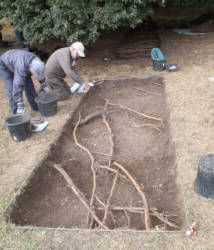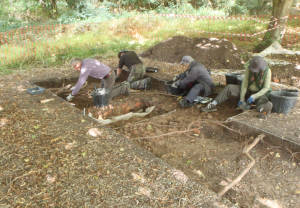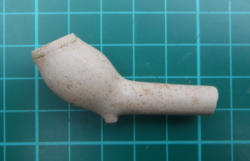28 Aug 2021
Forty Hall Summer Dig - Day 6

Not a great deal to report today, as we approach the halfway point in our two-week dig on the site of Elsyng Palace in the grounds of Forty Hall.
This morning we decided that it was not worth our time to continue pursuing the brick water conduit, since we seem to at least have proven fairly conclusively it does not run anywhere near where we think the inner gatehouse must be. So, while work will continue to finish excavating and recording the west end of trench one, most of our focus will now move over to trench two and the search for signs of the gatehouse itself.
The nearest thing we have found so far to in-situ structure has been large segments of mortared-together tiles in the east end of trench one, so in the hope that something structural must be nearby, we extended trench two six metres to the east, out into the middle of Forty Hall's lime tree avenue. We've removed the topsoil in this extension but have only just begun to remove the pebble-rubble context above the main rubble layer.

At the other end of trench two, we finished revealing the steeply-sloping coarse rubble deposit and planned and surveyed it ready for removal tomorrow. We're still not sure why the surfaces at this end of the trench have such a pronounced slope to them but they may be related to earthworks we identified from airborne laser scanning very nearby in the woods west of the lime avenue. There is also a linear magnetometry signal in that direction first identified in 1998, but if this represents part of the inner gatehouse we probably won't be able to access it this year since the woodland has expanded and become almost completely impassible in recent years.

Although there is a dearth of structural archaeology in trench two, the coarse rubble deposits are at least rich in finds. The star of today's show was the complete bowl of a very early clay tobacco pipe, which was found in the sloping rubble context.
This is one of the earliest and one of only three or four we've ever found of the site which probably date from the early seventeenth century, at a time when tobacco smoking was still a new phenomenon in England and tobacco prices were very high, hence the pipe's tiny bowl. In fact, most of the pipes we find at Elsyng generally date to the 1650s, and thus probably derive from the workers who were demolishing it, but this one may be early enough to have actually belonged to somebody who lived and/or worked here.